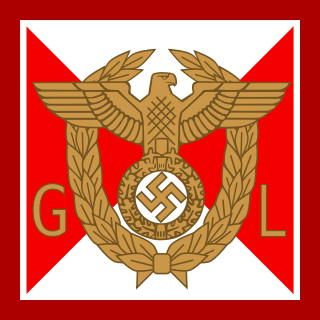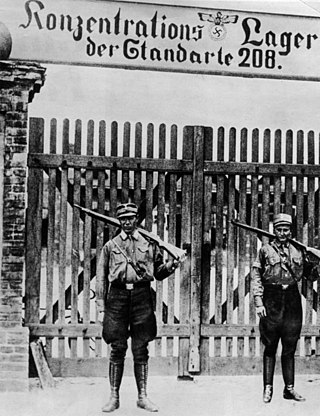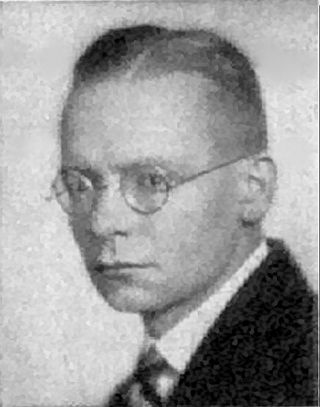
A Gauleiter was a regional leader of the Nazi Party (NSDAP) who served as the head of a Gau or Reichsgau. Gauleiter was the third-highest rank in the Nazi political leadership, subordinate only to Reichsleiter and to the Führer himself. The position was effectively abolished with the fall of the Nazi regime on 8 May 1945.

The uniforms and insignia of the Schutzstaffel (SS) served to distinguish its Nazi paramilitary ranks between 1925 and 1945 from the ranks of the Wehrmacht, the German state, and the Nazi Party.

The uniforms and insignia of the Sturmabteilung (SA) were Nazi Party paramilitary ranks and uniforms used by SA stormtroopers from 1921 until the fall of Nazi Germany in 1945. The titles and phrases used by the SA were the basis for paramilitary titles used by several other Nazi paramilitary groups, among them the Schutzstaffel (SS). Early SS ranks were identical to the SA, since the SS was originally considered a sub-organisation of the Sturmabteilung.

Stabschef was an office and paramilitary rank in the Sturmabteilung (SA), the paramilitary stormtroopers associated with the Nazi Party. It was a rank and position held by the operating chief of the SA. The rank was equivalent to the rank of Generaloberst in the German Army and to General in the U.S. Army.

Blockleiter, where block refers to city block, was from 1933 the title of a lower Nazi Party political rank responsible for the political supervision of a neighborhood. Referred to in common parlance as Blockwart, the Block Warden's duty was to form the primary link between the Nazi authorities and the general population. The derogatory term Blockwart ("snoop") survives in German colloquial language.
Haupttruppführer was a Nazi Party paramilitary rank that existed between the years of 1930 and 1945. Haupttruppführer was mainly used as a rank of the Sturmabteilung (SA), but was also used by the Schutzstaffel (SS) in the early days of that group's existence.

Ranks and insignia were used by the National Socialist German Workers' Party (NSDAP) as paramilitary titles between approximately 1928 and the fall of Nazi Germany in 1945. Such ranks were held within the political leadership corps of the Nazi Party, charged with the overseeing of the regular Nazi Party members.
Helfer (transl. Helper) was a paramilitary rank of the Nazi Party between the years of 1938 and 1945. The Nazi rank of Helfer was a junior position of the Political Leadership Corps, ranking only above Anwärter. A Helfer in the Nazi Party typically served as a junior assistant to a higher official. The rank was created at first to replace the older Nazi rank of Blockleiter; however, a massive expansion of Nazi Party ranks in 1938 assigned the old duties of a Blockleiter to a rank known as Arbeitsleiter. The rank of Helfer then became an assistant position to such higher ranks.

Theodor Habicht was a leading political figure in Nazi Germany. He played a leading role in the Austrian Nazi Party. During World War II, he was involved in the administration of Nazi-occupied Norway until his dismissal by Adolf Hitler. He later served in the Wehrmacht and was killed in action on the Eastern Front at Nevel in 1944.

Zellenleiter was a Nazi Party political title which existed between the years of 1930 and 1945. A Zellenleiter was higher in rank than a Blockleiter and was in charge of a "Nazi Cell", composed of eight to twelve city blocks.
Units and commands of the Schutzstaffel were organizational titles used by the SS to describe the many groups, forces, and formations that existed within the SS from its inception in 1923 to the eventual fall of Nazi Germany in 1945.
Wilhelm Karpenstein was a German Nazi Party politician. He served as Gauleiter of Pomerania from 1931 to 1934.

Abteilungsleiter, German for department head, was also a mid-level administrative political position of the Nazi Party, often held by staff political officers attached to various Gaue throughout Germany. The position of Abteilungsleiter was not an actual Nazi Party political rank, but a title held by a Party member in addition to their formal rank. The position was first created in 1933, after the Nazis had secured power in Germany.

Kreisleiter was a Nazi Party political rank and title which existed as a political rank between 1930 and 1945 and as a Nazi Party title from as early as 1928. The position of Kreisleiter was first formed to provide German election district coordination and, after the Nazi assumption of power, the position became one of county municipal government, effectively replacing the traditional German government establishment.

Dienstleiter was a high-ranking Nazi Party political rank of Nazi Germany which existed between 1933 and 1945. The rank was first created after the Nazi assumption of power and served as the second highest rank of the Reichsleitung Nazi Party organizational level, subordinate to the Reichsleiter.

Stützpunktleiter was a Nazi Party political rank which existed between 1933 and 1938. The rank was created as an adjutant position to the Ortsgruppenleiter of a German town or city. In 1939, the rank of Stützpunktleiter was phased out and replaced by several new paramilitary political ranks.

Gemeinschaftsleiter was a Nazi Party political rank which existed between 1939 and 1945. Created primary to replace the older rank of Stützpunktleiter, the rank of Gemeinschaftsleiter was often used on the local level of the Nazi Party to denote the second in command of a municipal region, answering to a regional Nazi known by the title of Ortsgruppenleiter.

Friedrich Krebs was a German lawyer and Oberbürgermeister of Frankfurt during Nazi Germany. In March 1933, Krebs, a fervent antisemite and member of the Nazi Party, ousted the previous mayor, Ludwig Landmann, who was Jewish. Within two weeks Krebs fired all Jewish city employees, even before the German Law for the Restoration of the Professional Civil Service formally removed Jews from government service.
Hans Albert Hohnfeldt was a member of the Nazi Party (NSDAP) who served as Gauleiter in the Free City of Danzig and acting Gauleiter of Gau East Prussia. He also held other Party and government posts in the Free City of Danzig.

Bezirksleiter was a Nazi Party title which was used in the early years of the Party's existence, beginning around 1926.














